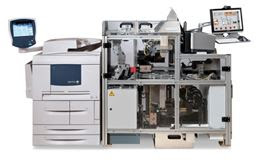The thing about self-publishing is, it's up to the author to establish a viable workflow, either by paying competent people, doing the work himself, or some combination of the two. To be clear, by workflow, I don't mean writing the book, I mean turning a manuscript into a printed book and/or or an ebook. I won't talk about audiobooks because I haven't created any.
I worked in publishing for almost 30 years, and those years saw a lot of change. As I was working for a publisher of legal and regulatory information rather than fiction, it was a very different workflow from producing novels. Over that span of time, my company's focus changed from print to digital because our customers were better served by information that could be delivered faster, updated more easily. and accessed from multiple places, as opposed to having to open a book or a binder on a shelf.
 |
| Espresso Book Machine |
In fiction publishing, that transition hasn't happened as thoroughly. Print is still very viable, but there is also a digital market—both ebook and audio. But the biggest change in fiction publishing has been the advent of self-publishing. Print-on-demand technology allows booksellers to print a book only when it has been ordered. The availability of ereaders (such as the Kindle), tablets, and even cell phones have created a market for ebooks, which are delivered via the web. Because of these two developments, self publishing has taken off. And now, individual authors are learning things abut producing books that traditional publishers have known for a long time .
Workflow is a huge part of publishing. If your book is published by a major publisher, your part of its workflow will consist mostly of turning in your manuscript, and reviewing and approving edits and the cover. There may be a lot of back and forth between you and the editor and publisher but that won't involve you creating the print or digital pages. With self-publishing, unless you hire someone to do workflow for you, you are on your own. The one part of workflow I always hire out is doing the cover, because in additon to artistic talent, it takes a lot of specialized skills I don't have. Page layout and ebook production are, for me, much easier tasks than creating a good-looking, marketable cover. The thing to remember about publishing a book is, it's never going to be perfect the first time! You need to be able to make edits, right up to and even after publication. And since you are publishing in multiple formats, you need to consider how those edits will be made. If you format the print edition yourself, you need to be able to create headers and possibly footers and paginate the main part of the book separately from the front and back matter. After some frustrating efforts to do page layout for my books with MS Word, I have been switched to Adobe InDesign for formatting my paperbacks (and two hardbacks!) partly because it can also output an epub file as well as PDF. InDesign is not easy to learn and you can no longer buy a copy outright, but it is available on a subscription basis per month. I find it useful because in addition to formatting books, it can create web page banners and similar files. It cannot edit individual images in the way that Adobe Photoshop does, but it lets you place one or more images on a page (print or digital) and add text and color. Also, once you know how, formatting a book in InDesign is very fast.



No comments:
Post a Comment